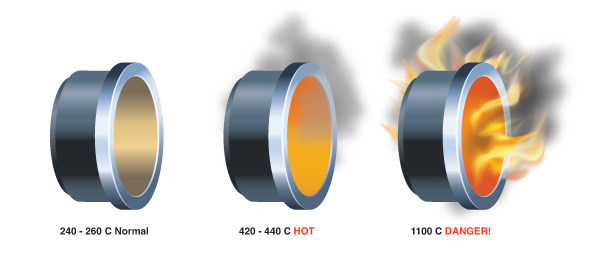Vehicle Braking Systems
If you are driving a vehicle equipped with air brakes, it is important to understand how an air brake system works and how it compares to other vehicle braking systems. This chapter outlines the fundamentals of the most common braking systems used in vehicles today.
Stopping a vehicle
To stop a moving vehicle, the brake shoes or pads exert pressure on the brake drums or rotors. The resulting friction produces heat that is absorbed and dissipated by the brakes and its components. Too much heat can result in brake fade, brake failure and even tire fire (See Diagram 1-1). As brake drums overheat, they expand to the point where they may not even contact the shoe. When brakes overheat due to overuse or improper adjustment, it is advisable to stop and allow them to cool before proceeding. While stopped, the driver should check all the brakes and their current adjustments.
Note: Ensure that brake assembly is cool to the touch prior to attempting any brake measurements.
Any single malfunctioning brake will increase the work of all the others, causing them to overheat quickly and possibly fail too.

Diagram 1-1
Air brakes differ from hydraulic brakes
Most brakes are located at the wheels of a vehicle. The force you apply to the brake pedal is transmitted to the wheels to make the brakes operate. There are two main ways in which this force is transmitted - hydraulic brake systems and air brake systems.
Hydraulic brake systems are used as the main braking system on almost all passenger vehicles and light trucks. Hydraulic brakes use brake fluid to transmit force when the brakes are applied. Since brake fluid cannot be compressed, force is transmitted immediately and directly at each wheel when you press the brake pedal.
Air brake systems are used on large commercial vehicles because they can develop and transmit high mechanical forces over great distances using simple components and connections. Air brake systems use compressed air, which is stored in tanks, to produce the force that applies the brakes at each wheel.
When you press the brake pedal, compressed air must travel from one part of the system to another. Special valves make sure that the air moves through the system as quickly as possible; however, there is a split-second delay in brake reaction from the moment you apply or release the brake pedal.
This split-second delay in brake reaction occurs in all air brake systems.
Components of air brakes
All vehicles using air brake systems have one of two major brake types at the wheels - drum brakes or disc brakes. You must be able to recognize the brake hardware - also called foundation brake components - used at the wheels of your vehicle.
Drum brakes use a drum with brake shoes and linings inside the drum. When you press the brake pedal, the brake shoes press outward against the drum’s surface.
Disc brakes use a disc-shaped rotor and a caliper containing brake pads. When you press the brake pedal, the pads press toward each other, clamping against both sides of the rotor’s surface.
You can find more information about foundation brake components in Chapter 6.
Other braking systems
Along with hydraulic and air brake systems, there are a number of other kinds of braking systems used in vehicles. For example:
- Air-over-hydraulic brakes are used mainly on medium-duty commercial vehicles. This system uses compressed air in combination with a hydraulic brake system. (You must have an air brake endorsement on your driver’s licence to drive a vehicle with air-over-hydraulic brakes in Ontario.)
- Air parking brakes are used on some medium-duty vehicles such as school buses. This system provides an air-operated parking brake and a hydraulic brake system for all other braking. (You do not need an air brake endorsement on your driver’s licence to drive a vehicle with air parking brakes.)
Key points to remember
- Brakes convert the energy of a moving vehicle into heat.
- Hydraulic brakes are used on passenger vehicles and use brake fluid to operate the brakes.
- Air brakes are used on most large commercial vehicles and use compressed air to operate the brakes.
- A split-second delay in brake reaction is present in all air brake systems.
- Vehicles with air brakes may use either drum or disc type components.